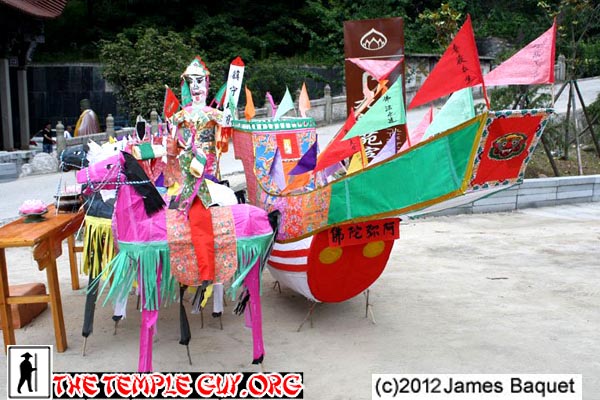(1) Yesterday's "Dabeilou" is in fact Zhantan Lin, one of the temples on my list. Most of the pictures I'll show you are of the three big, new (cold, unattractive) front halls, all of which I saw yesterday. Then I'll show you what I "found" today.
This is one of the two side halls--the one to the right of the center hall--and dedicated to Dizang. Notice anything strange? No front steps! You have to get onto the terrace from the side. The two side halls are identical except for this.
(2) In that right-hand hall, there are four standing Dizangs back-to-back in the center, and "99" seated ones around the sides, according to the monk-attendant.
(3) An unusual pair to see inside a Buddhist temple (though I've seen them outside other Buddhist temples): Mr. and Mrs. Earth God, on the side platform inside the Dizang Hall.
(4) A corner shot of the main, central hall, which I showed you head-on yesterday.
(5) The life-sized, realistic elephants flanking the central hall are magnificent.
(6) The main figures in the central hall are huge, but don't they look a little cartoonish? They're the Huayan Triad of Puxian (Samantabhadra, left); Shakyamuni; and Wenshu (Manjushri, right). The two on the sides are often seen on an elephant and a lion, respectively, but here they're on lotus seats.
(7) The left-hand hall is nearly the same as the right-hand one, so I haven't shown its exterior. Inside, it contains a massive, four-sided, thousand-armed Guanyin, in this eight-sided glass container.
(8) The left hall has appearances of Guanyin numbering 84 (by one monk's count) or 116 (by another--I didn't take time to do it myself).
(9) I found the fourth hall today, only through perseverance. It's at the back of the property, and hidden behind a temple hotel (unlike the front three, which are out on the street with no compound around them). It's the oldest of the "four great halls," but still only half as old as me.
(10) Look how badly the fourth hall was treated: that's the bottom of the steps, actually notched into the hotel. No grand approach.
(11) Here's the best shot I could get of the fourth hall, which is really the "main hall" dedicated to Shakyamuni. That's the overhang of the hotel porch's roof at the top of the picture.
(12) The back doors of the fourth hall are from the Ming Dynasty, according to the young monk stationed nearby. They look like they haven't had a paint job since.
(13) Here is Dizang with his attendants, as they are depicted throughout China. At last, let me tell the story as briefly as I can: When the Korean monk came here, the mountain was owned by a rich old man. The monk asked for as much land as his outer robe would cover, as a place for meditation. The old man said, "Sure! Why not?" and the monk threw his outer robe in the air, which proceeded to cover the entire mountain! Knowing he'd been had, the old man good-naturedly let the monk have it, and even gave his son as a disciple. So Dizang is often depicted with the rich old donor on the left (his right), and the old man's son (the monk) on the right (his left).
(14) In the main (fourth) hall is the gilded mummy of monk Ming Jing, who died in 1992 and was "sealed in a jar." When the jar was opened six years later, "his body was not corrupted. His face is vivid, his skin is fresh." So they gold-foiled him and venerate him; it's a repeated story here on Jiuhuashan (see the next temple for what may be the original).
(15) At the far back of this property is this ragged little hall, all that's left of the old temple before the "renovations" (destruction) started in the early 90s. The monk proudly told me there are "four great halls," not counting this one at all.
(16) Squeezed into that little hall is this good-sized "Sleeping Buddha" (the Buddha as he enters Nirvana=dies). The hall could barely accommodate him!
(17) These paper figures (a boat, an admiral, and four horses) will be used in the Dragon Boat Festivities tomorrow.
| ← Previous Site | Back to Trip 16 Introduction | Next Site → |
Last Updated August 15, 2019


















No comments:
Post a Comment